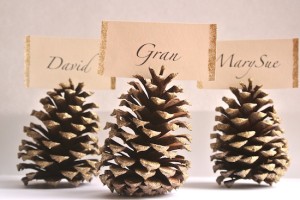
Fall is a beautiful time of year and nature is full of gifts. Aside from the planned bounties from planted gardens, wild areas and spent garden plants provide “free” decorations. Tall grasses, milkweed, cornstalks, dried berries, flowers, pods, nuts, cones and branches are just a quick list of items that can be converted to interior decorations. Now is the time to collect nature.
If there is a black mildew on your chosen plant, spray it with a bleach solution. Although the plants have started to die off and dry where they are growing, continue to dry for several weeks inside a garage or shed. I sometimes hang the foliage upside-down from the rafters, which allows the stalks to dry upright.
After they are dry, you have the option to spray them with a matte poly coating that will allow their natural colors to be retained, or select a color in a spray paint can. The metallic gold, silver and copper spray paints work very well for the holidays. I have taken silver-sprayed dill heads, dipped them into a plate of glue, then into a plate of glitter . . . very sparkling and very inexpensive glitz.
While fruits like pumpkins and gourds do not have to be sprayed with a fixative, spraying them will extend their shelf life (though it will also make them inedible).
If you are going to create an arrangement with your collected items, select a container that balances the arrangement. Visually, the container and the arrangement should not be equal. I would choose to have the arrangement bigger than the container, emphasizing the arrangement.
When done with your natural arrangements, don’t throw them in the trash. Return them to nature, where they will decompose and become part of the soil.
 Seed Collecting
Seed Collecting
This is also the time of year to collect seeds. Always choose to harvest from the best plants: biggest, most flavorful, most productive or other choice characteristics. Disease-free heirloom varieties are good candidates. Avoid saving seeds from hybrid plants, as their seed is often sterile or does not reproduce true to the parent plant. If you are not sure whether you have a standard (heirloom) or hybrid, don’t put any effort into saving their seeds. Next year, buy standard, heirloom or F2 plants, all of which have savable seeds.
Many gardeners successfully keep seeds saved from beans, tomatoes, lettuce and peppers, all self-pollinating plants. With self-pollinated crops, the pollen is transferred directly to the stigma within the flower. Different varieties can be planted several rows away from each other.
Crops that are not self-pollinated will be pollinated by wind/air or insects. The cross-pollination production of seeds is an area where commercial seed growers excel. If the seed produced is to have the same genetic composition as the original plant, it must be pollinated with pollen from the same variety. There are distance requirements for varieties, so the average home gardener does not bother saving seed from vegetables pollinated by wind and insects.
Leave bean pod crops on the vine until the pod dries. Then remove the pod from the vine and break open the pod to access the seed. Seed heads from herbs and flowers can be removed from the plant after they dry but before they drop. I have often dried the fleshy fruit with seeds from a tomato or a pepper on a paper towel. An alternate for these vegetables is to scoop the seed mass out and place with a small amount of warm water in a bucket or jar. Let the mixture set for two to four days. Stir daily. This is a fermentation process and kills viruses. It also separates the good seed from the bad seed and fruit pulp. The good, viable seeds will sink to the bottom of the container while the pulp and bad seed float. Pour off the pulp, water, bad seed and mold. Spread the good seed on a screen or paper towel to dry.
Seeds must be stored dry. Place them in a glass jar or envelopes. Marilyn Rogan, a Rutherford County Master Gardener, gave a class at the Farmers’ Market this year where she introduced the idea of using a roll-up shoe bag for organization. Label with the seed variety and year harvested. Put in the freezer for two days to kill any pests. Then store in a cool dry location like a refrigerator. Seed that grows mold was not sufficiently dry before storage. Throw it out.
Seed viability decreases over time. Most seed should be used within three years.
People more experienced than myself have advised against depending completely on collected seeds for your garden. When you purchase seeds next year, do consider heirloom seeds for next year’s seed harvest.
 Farmers’ Market Classes
Farmers’ Market Classes
This is the final month for classes this year as the Market closes at the end of October. These classes are free to the public. They are held at 9 a.m. on Tuesdays and Fridays at the Lane Agricultural Park’s Community Center, 350 John Rice Blvd.
Oct. 2 – Polly Rooker, TWRA Biologist: Native Bees, The Unknown Soldiers
Learn about the more than 4,000 U.S. native bee species and what you can do to attract and support them.
Oct. 6 – Catie Beth Thomas: Nature Weaving
Want to learn about weaving? Bring any pieces if fabric, dried flowers, and/or shells that hold a special place in your heart.
Oct. 9 – Linda Lindquist, CMG: Lasagna Gardening
A way to create a garden bed for your flowers or veggies with no digging and no tilling.
Oct. 13 – Art Whitaker and Ben Hodge, Mid-State Brew Crew: Homebrewing 101
Learn the basic principles of making your own beer at home.
Oct. 16 – Tony Johnston, MTSU: Apple Preservation
It’s easier than you think! Lean how to prepare and put away the harvest for the winter ahead.
Oct. 20 – Jennifer Joines and Brenda Davis, CMG: Don’t Let your Muscles Winterize!
Tips to stay in shape so that you’re prepared for next season.
Oct. 23 – Cynthia Allen, MTSU Stormwater Coordinator: A Rain Garden, More than Just a Pretty Space!
Combine beauty and function by installing a rain garden! Find out what they are, how they work, and how to plan your own. We’ll visit one onsite, talk about more local examples and share lots of cool resources.
Oct 27 – Carla Bush, Ext. Agent: Seasonal Eating, Going Green
Green vegetables aren’t just for summer. Fall brings out the flavor in green vegetables and makes your meals a hit.
Oct. 30 – Tony Johnston, MTSU: Homemade Mead
How to make the sweet stuff at home! Perfect DIY gift for family and friends.













